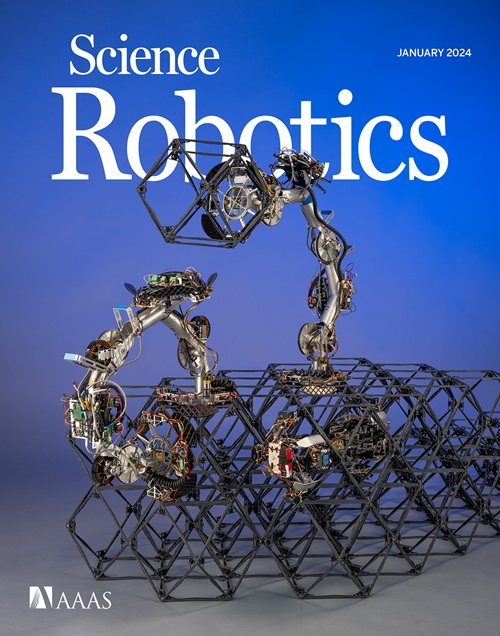受松鼠平衡控制启发的单足机器人分支间跳跃和着陆
IF 27.5
1区 计算机科学
Q1 ROBOTICS
引用次数: 0
摘要
移动机器人在穿越树木环境时必须经常跳过大的间隙,降落在小直径的支撑物上。由于高入射动量、有限的落脚点选择以及在窄支架上产生反力扭矩的能力降低,平衡这些动态着陆具有挑战性。我们假设腿长控制可以增强分支反应控制权限,从而显著扩大成功着陆条件的范围,利用跳跃所需的同样强大的腿部驱动。为了探索这种平衡策略,单足机器人Salto-1P展示了分支间的跳跃,包括一些直立平衡着陆,尽管抓取力矩可以忽略不计。我们还将这种着陆策略与松鼠的着陆策略进行了比较,松鼠同样缺乏其他树栖物种的握力。我们证明了更大的径向力控制减少了惯性体扭矩和/或在平衡给定着陆所需的支撑处的抓取扭矩。在传统的平衡控制器中加入简单的径向力平衡控制策略,极大地扩展了潜在的着陆条件,在低阶模型中,机器人和松鼠在着陆角度范围内可平衡的初始角动量范围分别增加了230和470%。本文章由计算机程序翻译,如有差异,请以英文原文为准。
Monopedal robot branch-to-branch leaping and landing inspired by squirrel balance control
Locomotors traversing arboreal environments must often leap across large gaps to land on small-diameter supports. Balancing these dynamic landings is challenging because of high incident momentum, restricted foothold options, and reduced capacity to produce reaction torques on narrow supports. We hypothesized that leg length control to enhance branch reaction control authority would markedly expand the range of successful landing conditions, drawing on the same powerful leg actuation required for leaping. Exploring this balance strategy, the monopedal robot Salto-1P demonstrates branch-to-branch leaps, including some upright balanced landings, despite negligible grasping torque. We also compared this landing strategy with the landings of squirrels, which similarly lack the grip strength found in other arboreal species. We demonstrate that greater radial force control reduces the inertial body torque and/or grasping torque at the support required to balance a given landing. Adding simple radial force balance control strategies to conventional balance controllers greatly expands potential landing conditions, increasing the range of initial angular momentum that can be balanced by 230 and 470% across ranges of landing angles for low-order models of the robot and squirrel, respectively.
求助全文
通过发布文献求助,成功后即可免费获取论文全文。
去求助
来源期刊

Science Robotics
Mathematics-Control and Optimization
CiteScore
30.60
自引率
2.80%
发文量
83
期刊介绍:
Science Robotics publishes original, peer-reviewed, science- or engineering-based research articles that advance the field of robotics. The journal also features editor-commissioned Reviews. An international team of academic editors holds Science Robotics articles to the same high-quality standard that is the hallmark of the Science family of journals.
Sub-topics include: actuators, advanced materials, artificial Intelligence, autonomous vehicles, bio-inspired design, exoskeletons, fabrication, field robotics, human-robot interaction, humanoids, industrial robotics, kinematics, machine learning, material science, medical technology, motion planning and control, micro- and nano-robotics, multi-robot control, sensors, service robotics, social and ethical issues, soft robotics, and space, planetary and undersea exploration.
 求助内容:
求助内容: 应助结果提醒方式:
应助结果提醒方式:


